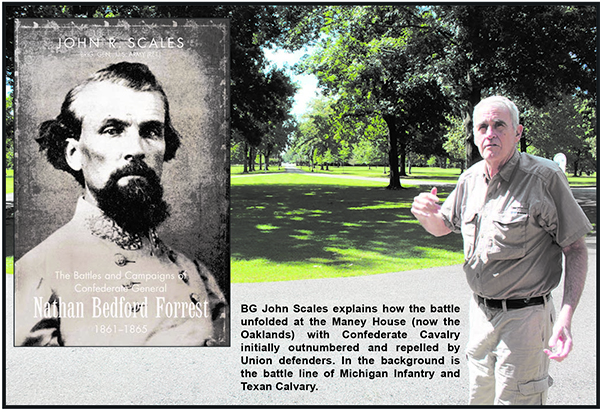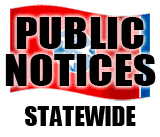
It began with a Facebook post. Brigadier General (ret.) John Scales had seen the plans of one of his former Soldiers in Cannon County. He suggested the addition of Civil War battlefield tours. The Soldier was in complete agreement, and though a student of history himself, admitted he had a lot more research and study to do on local battlefields.
General Scales is not only the former commander of 20th Special Forces Group (Airborne), but a military historian, and an author, with a third book published this fall. His research into the war actions of General Nathan Bedford Forrest had previously brought him to Cannon County, and he offered to provide a personal tour of history to his former Soldier.
They met at the County Courthouse, for a lesson worthy of college level credit. Here, he gave the background and strategic goals of the two Armies fighting for control of Middle Tennessee.
Brigadier General (BG) Forrest had not yet received his promotion orders, but he had received his battle orders to delay the Union Advance. He had taken command of a 2nd Cavalry Brigade in Chattanooga comprised of Texans, Georgians, and Kentuckians. To this, was added a contingent of Tennessee Cavalrymen under Major Smith in McMinnville, with greater knowledge of the area.
His new command lacked significant experience of Victory. The Troops which had experience of battle, had instead tasted the bitterness of defeats. As many more had yet to encounter the chaos at all. The enemy they would face were already confident having been battle tested and proven.
BG Forrest had marched his force North to McMinnville and then West, resting his men and horses East of Woodbury, where he learned of townsfolk held prisoner in Murfreesboro, and under threat of execution.
While Union forces controlled the railroads from Nashville to Tullahoma, Murfreesboro was a smaller force than the front or the capital. His orders were to delay the advance of General Buell's Army on Chattanooga to allow General Bragg's Army to move from Tupelo, Mississippi to Middle Tennessee.
He received information from the people of Woodbury and the Tennessee Cavalrymen of a Union Command in disarray in Murfreesboro. LTC Parkhurst and COL Lester's feud had led to a disjointed unit located in 3 places and caused the Union command to reassign BG Crittendon and COL Duffield to take command. They arrived as BG Forrest reached McMinnville.
From the square, the Veterans traced the route of General Forrest into Murfreesboro, along the Old Nashville Highway. The Confederate 2nd Cavalry had marched 48 miles, with a short rest halfway to arrive at 4:30 am to commence the battle.
The Union forces had set up pickets around Murfreesboro and BG Forrest halted his Brigade over a mile out from the first picket, beyond a small rise. Here, he dispatched a contingent of the Tennessee Cavalry to circle around the Union Cavalry, approaching from Union lines under the guise of being Pennsylvanian Cavalry, which surprised the Union pickets, who surrendered without a shot.
As the Brigade resumed movement, it encountered a second line of picketers, possibly emplaced by the newly arrived Union Commander in Murfreesboro. The few shots fired in dispatching the 2nd Picket was sufficient to alert the 9th Michigan Infantry Regiment and 3/7th Pennsylvania Cavalry Regiment of the 23rd Brigade under the recently arrived Colonel (COL) Duffield in Murfreesboro.
Facing a numerically superior, entrenched force, General Forrest divided his forces against 3 locations. Six companies of Texas Rangers under COL Wharton moved up Highland St (then High St) and attacked the teamsters encamped in Murfreesboro and the Pennsylvania Cavalry, following on to the Maney House (now the Oaklands) along with two companies of Kentucky Cavalry and two of Tennessee Cavalry under Major (MAJ) Smith which had marched up Maney Street with the follow on mission of delaying the Minnesota Infantry.
Here the Cavalry under Major Smith moved out to stall the reinforcements of the 3rd Minnesota Infantry Regiment and B Battery of Kentucky Artillery in the Murfree house north of town from reinforcing embattled elements in town, while COL Wharton's Texans attacked the Brigade forces in town. A 3rd force of Georgian Cavalry and Texas Rangers under COL Morrison and BG Forrest attacked the courthouse, jail, and officer quarters on the Square. (The location of the 3rd Minnesota is now unrecognizable due to modern development.)
The 9th Michigan held off the Texan Rangers, as the sides were evenly matched, but the commander, COL Duffield was gravely wounded. The Rangers were forced to pull back to Main Street, with their own wounded commander.
MAJ Smith was able to draw the 3rd Minnesota out of camp and into a hilltop position, where COL Lester held the superior position from which he would fire but not attack or reinforce.
Though COL Morrison faced the smallest force in the County Square, it was the most defendable. His attacks were channelized up a street into a fortified brick building. The attack which had begun at 4:30AM was not won until 8AM, with considerable cost and innovation. Before it was done, a Union Soldier had set fire to the jailhouse (now a music store) with Woodbury prisoners jailed inside and dismounted Confederate Cavalry had set fire to the Courthouse.
Forrest stormed the Square, losing many men and failed. He dismounted the Texans, clearing the buildings surrounding the Square, while sending the Georgians to block approaches to the Square. The Provost Guard of the Union had barricaded the courthouse and jailhouse. After numerous attacks, the Texans were able to suppress Union fire long enough for the Georgians to close and set the Courthouse on fire.
The first victory of the day was the town square, which included the surrender of BG Crittendon and the recovery of the Woodbury townsfolk. It also returned the Texans to the battle at the Maney House and some of the Georgians to the battle against the 3rd Minnesota on the Nashville Pike. By this time, the 2nd Cavalry had in excess of 200 Union prisoners from several locations around town.
BG Forrest's officers advised to take the hard fought Victory and return with the spoils of battle to McMinnville. He responded with "I didn't come here to make half a job of it. I'm going to have them all."
Sending Texan reinforcements to COL Wharton, he took a portion of the Georgians to reinforce MAJ Smith to the North. Even outnumbered 500 to 700, COL Lester held the superior position, with high ground and artillery. BG Forrest recognized the futility of a frontal assault and instead attacked the encampment, overrunning and capturing another 100 Union Soldiers and setting the camp ablaze. This kept COL Lester and the 3rd Minnesota frozen on superior ground, demoralizing the troops under a commander unwilling to reinforce the 9th Michigan.
BG Forrest left the 1st Georgia to hold Lester in place, while the Tennesseans under MAJ Smith and the 2nd Georgia returned to the square and fought North to the Maney House. As the reinforcements converged from the West and East, the Texans reappeared from the Southeast. BG Forrest called for a ceasefire and sent Lieutenant Colonel (LTC) Parkhurst a demand for surrender. Outnumbered 700 to 132 (unwounded) and after consultation with the wounded COL Duffield, LTC Parkhurst surrendered.
In the battle, the senior officers of both sides were wounded in the initial battles.
One Union Soldier escaped to warn COL Lester of the outcome at the Maney House, which led him to retreat to the Murfree House several hundred yards from his previous position and North on the Nashville Highway. BG Forrest sent his adjutant, with a captured Union officer, under the flag of truce to demand the surrender of COL Lester and the 3rd Minnesota.
COL Lester requested a consultation with the wounded COL Duffield, which BG Forrest granted. Forrest gave safe passage, arranging for the Union Colonel to encounter the same Confederate Cavalry numerous times along the way and back, presenting the appearance of an even larger force, after which COL Lester called a council of war with his officers and he recommended surrender.
At the end of the day, Forrest marched the entire Union encampment at Murfreesboro back through Woodbury, paroling them in McMinnville. In the more civil days of war, an enemy prisoner was "paroled" on promise of his word to not return to battle unless specific circumstance was attained. Union enlisted assisted in bringing the wagon trains to McMinnville in exchange for a ride on the wagons. Forrest's Cavalry had taken more than 1200 Union enlisted Soldiers prisoner and encamped in Readyville that night, returning the Woodbury Citizens to their homes along the route.
General Forrest's ability to use the terrain in classic guerilla tactics of hit and run against larger forces made him very successful on the battlefields of his own choosing, and he chose well. His ability to learn from losses and adapt to the realities of the battlefield he faced led him to military successes. His operations in Middle Tennessee were the beginning of a level of command which afforded him operational control, rather than tactical, under the orders of others.
After a quick lunch at the Lion's Den, the pair of Veterans embarked on an abbreviated tour of less successful actions of BG Forrest in Cannon County including an attack on a Wagon Train East of Woodbury, followed by a ride through "the Barrens" to an attack a railroad trestle near Morrison.
Of course, the conversation between two modern Veterans strayed from the battles of 152 years ago. There were comparisons and contrasts of great leaders, tactics, and strategies of old versus current and the common leaders between their ranks of their unit, as well as terrain of modern battlefields they had both known, and perceptions from above and below of what went and is going right or wrong.
As the two Veterans completed their tour and history lesson with a return to the Courthouse, they wished they had more time, both to catch up on old times, as well as to explore the other actions of General Forrest in the County and the future plans of the Soldier within the County. The book "The Battles and Campaigns of Confederate General Nathan Bedford Forrest," published by Savas Beatie is available for pre-order on Amazon and will include driving tours of the exploits of BG Forrest in the Civil War, including those in Cannon County.
Both Soldiers trace their roots to Middle Tennessee during the period following the Revolutionary War, with a long line of officers and Generals preceding BG Scales, whose family moved further South and many enlisted preceding the retired Sergeant First Class. It is unknown how many times their ancestors served on the same battlefields together, but both families served in many of our Nation's wars.
BG Scales graduated the University of Alabama in 1970. He served as a Platoon Leader from 1971-72 with the 82nd Airborne in Vietnam, later joining 20th Special Forces Group, rising from ODA commander to Group Commander. After retiring as the Deputy Commander of the US Army Special Forces Command in 2001, he was called back to Active Duty to lead a Joint Special Operations Task Force in Afghanistan in 2002. BG Scales is a past President and current member of the Tennessee Valley Civil War Roundtable in Huntsville and leads campaign tours in Alabama, Georgia, and Tennessee. He is likely to be seen presenting the history of Civil War battles to Veterans in and around Cannon County in the year to come.






